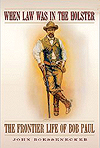 When Law Was in the Holster: The Frontier Life of Bob Paul, by John Boessenecker, University of Oklahoma Press, Norman, 2012, $34.95
When Law Was in the Holster: The Frontier Life of Bob Paul, by John Boessenecker, University of Oklahoma Press, Norman, 2012, $34.95
Bob Paul made a big impression wherever he traveled—pretty much around the globe as a whaler and across the American West as a miner and a lawman. Physically, he was dominating, at 6-foot-4 and 240 pounds, with thick brown hair, steely blue eyes, broad shoulders, a barrel chest and a head like a bullmastiff. But there was more. His signature humility and good humor notwithstanding, the lawman possessed a confidence that carried him safely through many a frontier scrape. Good folks liked him, while badmen just knew he was tough.
Wild West was fortunate to publish a preview of this meticulously researched biography in August 2012, when author John Boessenecker wrote “Gunfight of the Sierra Madre,” an account of Paul’s Mexican showdown with a trio of fugitive train robbers. The introduction to that article and his book are an eye-opener for the uninitiated:
Although he rates as one of the great peace officers of the Old West, Paul is remembered today principally for his friendship with Wyatt Earp and the stirring events both before and after the October 26, 1881, gunfight near the O.K. Corral in Tombstone, Arizona Territory. But Paul had been a veteran lawman in Gold Rush California while the Earp brothers were still wearing knee pants. For nearly 50 years he enforced the law without fear or favor on two of the wildest frontiers of the Old West.
The Massachusetts-born Paul got his first glimpse of the West when he clambered from the deck of a schooner to the San Francisco waterfront in January 1849, after nearly seven years at sea. Two months earlier while docked in Hawaii, he and shipmates had heard news of the California Gold Rush. Despite his officer’s bars and the likelihood of a future captaincy, Paul succumbed to temptation. Granted a discharge, he boarded the next available eastbound schooner. “For Bob Paul and the tens of thousands of gold seekers who would soon follow, San Francisco was the jumping-off place for the mines,” the author writes. And jump he did, from boomtown to boomtown in the Sierra foothills.
Like so many other hopeful Forty-Niners, Paul didn’t strike it rich, but he did find his calling. Fearless and with an unwavering sense of justice, he threw himself into the midst of mob violence and drunken brawls, eventually making it official in 1854 as constable of rough-and-tumble Campo Seco. Paul never looked back, serving the next half-century as a sheriff, shotgun messenger, railroad detective and U.S. marshal from Calaveras County, Calif., to Arizona Territory and tough spots in between. Along the way he shut down outlaw gangs, started and ended gunfights, confronted vigilantism, touched off the Tombstone troubles, became embroiled in nasty frontier politics and bumped up against the still-relevant issues of immigration, border security and racism.
Surviving the odds, Bob Paul died with his boots off in Tucson on March 26, 1901. “Though he died on the brink of poverty,” Boessenecker writes, “few men on the frontier lived a life so rich.” A century later the author has finally given this legendary lawman his due.
Dave Lauterborn




